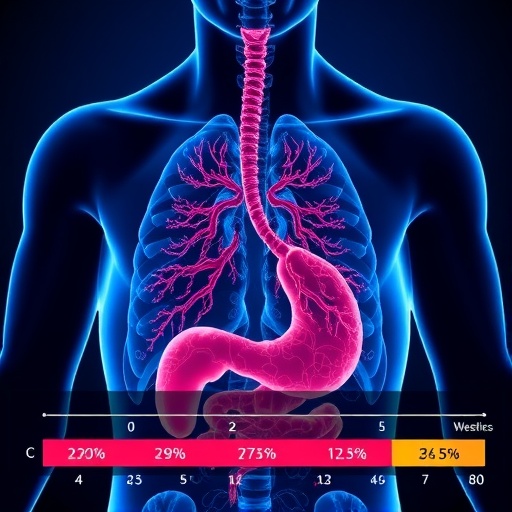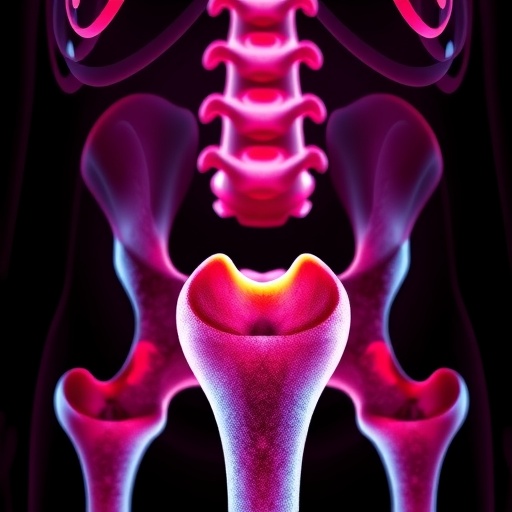In a groundbreaking study that could redefine treatment strategies for gastric and gastroesophageal junction (G/GEJ) cancers, researchers have unveiled critical immune signatures that predict patient responses to first-line anti-PD-1 immunotherapy and platinum-based chemotherapy. This research, published in BMC Cancer, offers new hope in personalizing therapies for a disease that remains notoriously difficult to treat due to heterogeneous responses.
Gastric and gastroesophageal junction cancers are among the leading causes of cancer-related mortality worldwide. Traditional first-line treatments primarily involve platinum-based chemotherapy, often combined with immune checkpoint inhibitors targeting programmed cell death-1 (PD-1). However, the effectiveness of these treatments varies widely among patients, underscoring the urgent need for reliable predictive markers that can guide therapeutic decisions.
The immune landscape within the tumor microenvironment (TME) plays a pivotal role in shaping treatment outcomes. Despite the clinical relevance, the precise role of immune cell infiltration in predicting response to both anti-PD-1 therapy and chemotherapy remained ambiguous—until now. The recent study meticulously links specific immune cell patterns in the TME with patient prognoses and therapeutic efficacy in G/GEJ cancers.
.adsslot_CzvM2FDY0O{width:728px !important;height:90px !important;}
@media(max-width:1199px){ .adsslot_CzvM2FDY0O{width:468px !important;height:60px !important;}
}
@media(max-width:767px){ .adsslot_CzvM2FDY0O{width:320px !important;height:50px !important;}
}
ADVERTISEMENT
The investigation leveraged data from the ORIENT-16 clinical trial, a rigorously designed, phase 3, randomized, double-blind, placebo-controlled study involving 650 patients with unresectable locally advanced or metastatic G/GEJ cancer. Focusing on a subset of 54 patients enrolled at the First Affiliated Hospital of Zhejiang University School of Medicine, the research team integrated advanced multiplexed immunofluorescence (mIF) techniques with cutting-edge digital image analysis and machine learning algorithms to decode complex immune profiles.
By quantifying markers such as CD4, CD8, PD-L1, CD68, and FoxP3 within the tumor stroma, researchers identified distinct immune signatures correlating with clinical outcomes. A key finding was the differential expression of the PD-L1 protein, which serves as a primary ligand for the PD-1 receptor. Notably, patients exhibiting high tumor stromal PD-L1 density demonstrated superior survival rates when treated with anti-PD-1 immunotherapy, underpinning PD-L1’s role as a predictive biomarker for immunotherapy responsiveness.
Interestingly, this correlation was reversed in patients undergoing platinum-based chemotherapy. Elevated PD-L1 levels in this cohort were associated with diminished therapeutic benefit, indicating that high PD-L1 expression may predict resistance to chemotherapy. These insights suggest that measuring PD-L1 expression in the tumor microenvironment could be instrumental in determining the optimal first-line treatment modality for individual patients.
Beyond PD-L1, the study illuminated the prognostic significance of T-cell subsets within the tumor milieu. High levels of stromal CD8-positive T cells, which are cytotoxic lymphocytes pivotal for anti-tumor immunity, were linked with favorable responses to anti-PD-1 therapy. This discovery provides compelling evidence that a robust cytotoxic immune presence can enhance checkpoint blockade efficacy.
Conversely, a high density of stromal CD4-positive T cells correlated with poor prognosis in patients receiving chemotherapy. This finding challenges previous assumptions about CD4 T cells in cancer and highlights the complexity of immune interactions influencing chemotherapy outcomes. The differential roles of T-cell subsets emphasize the heterogeneity of the immune landscape and its nuanced impact on therapy.
The research utilized a sophisticated multiplexed immunofluorescence approach, enabling simultaneous visualization and quantification of multiple immune markers within a single tissue section. Coupled with digital image analysis and machine learning, this methodology allowed for unprecedented precision in characterizing immune cell populations, offering a powerful platform for biomarker discovery.
Another salient aspect of the study was the temporal dimension of survival disparities. For patients with PD-L1 combined positive score (CPS) below 10, differences in survival between the immunotherapy and chemotherapy groups became pronounced only after approximately 300 days of treatment. This finding suggests that immune-mediated effects may manifest more significantly over extended timeframes, reinforcing the importance of longitudinal assessment in clinical trials.
The implications of these findings are far-reaching. By integrating immune profiling into clinical decision-making, oncologists could potentially stratify G/GEJ cancer patients more effectively, tailoring treatment to maximize efficacy while minimizing unnecessary toxicity. This precision oncology approach promises to enhance survival outcomes for a patient population that has historically faced limited therapeutic options.
Moreover, the study paves the way for exploring combination therapies that modulate the tumor immune microenvironment. Understanding how different immune cells influence response to various treatments can inform the design of next-generation therapeutic regimens, including novel checkpoint inhibitors, immune agonists, and chemotherapeutic agents.
It is also noteworthy that the ORIENT-16 trial was conducted under stringent protocols, ensuring data reliability. With 650 patients enrolled, its robust design lends strong statistical power to the findings, though this particular immune signature study was limited to 54 patients from a single institution. Larger-scale validation studies will be necessary to confirm these biomarkers’ clinical utility across diverse populations.
From a technical perspective, the implementation of machine learning algorithms in analyzing immunofluorescent images represents a significant advance in digital pathology. These algorithms facilitated the objective and reproducible quantification of immune markers, overcoming variability inherent in manual assessments and accelerating translational research.
The study’s authors emphasize that the interplay between PD-L1 expression and immune cell infiltration within the tumor microenvironment constitutes a complex network influencing treatment responsiveness. Their work, therefore, underscores the need for comprehensive biomarker panels rather than single-parameter assessments.
Future research directions include investigating the mechanistic basis of how CD4 and CD8 T cells differently modulate the response to chemotherapy and immunotherapy. Additionally, integrating genomic and transcriptomic data with immune profiling could provide a more holistic understanding of tumor biology in G/GEJ cancers.
These findings resonate within the broader oncology community, where the challenge of overcoming resistance to immunotherapy remains paramount. By elucidating immune correlates of treatment success, this study adds a vital piece to the puzzle of cancer immunotherapy personalization.
In conclusion, this pioneering investigation delineates the immune signatures within the tumor microenvironment that predict clinical responses to first-line anti-PD-1 blockade and chemotherapy in gastric and gastroesophageal junction cancers. The identification of PD-L1 expression levels and T-cell subpopulations as predictive biomarkers offers a roadmap toward more individualized, effective treatment strategies. As these insights transition into clinical practice, they hold the promise of significantly improving patient outcomes in one of oncology’s most challenging arenas.
Subject of Research: Predictive immune signatures for response to first-line anti-PD-1 immunotherapy and chemotherapy in gastric/gastroesophageal junction cancer.
Article Title: The immune signatures predict gastric/gastroesophageal junction cancer response to first-line anti-PD-1 blockade or chemotherapy.
Article References:
Wu, H., Shu, W., Ding, Y. et al. The immune signatures predict gastric/gastroesophageal junction cancer response to first-line anti-PD-1 blockade or chemotherapy. BMC Cancer 25, 1369 (2025). https://doi.org/10.1186/s12885-025-14805-6
Image Credits: Scienmag.com
DOI: https://doi.org/10.1186/s12885-025-14805-6
Tags: anti-PD-1 immunotherapy effectivenesscancer-related mortality and treatment strategiesclinical trial data for cancer treatmentheterogeneity in cancer treatment responsesImmune checkpoint inhibitors in cancer therapyimmune signatures in gastric cancernovel biomarkers for cancer therapypersonalized therapy for gastric cancerplatinum-based chemotherapy in G/GEJ cancerspredicting treatment response in gastroesophageal cancerprognostic markers in oncologytumor microenvironment and immune cell infiltration





